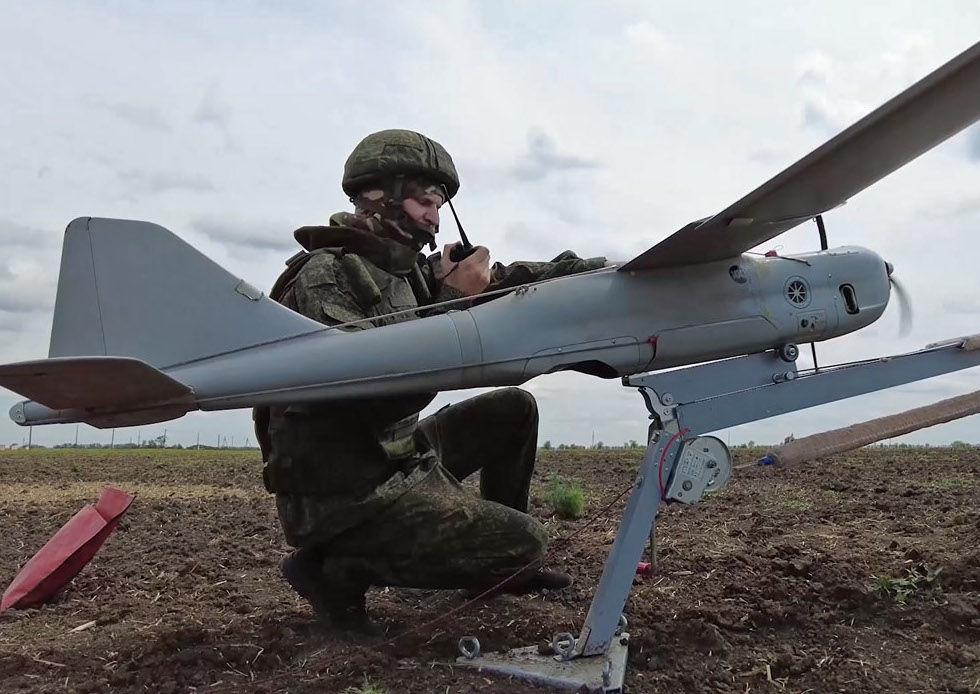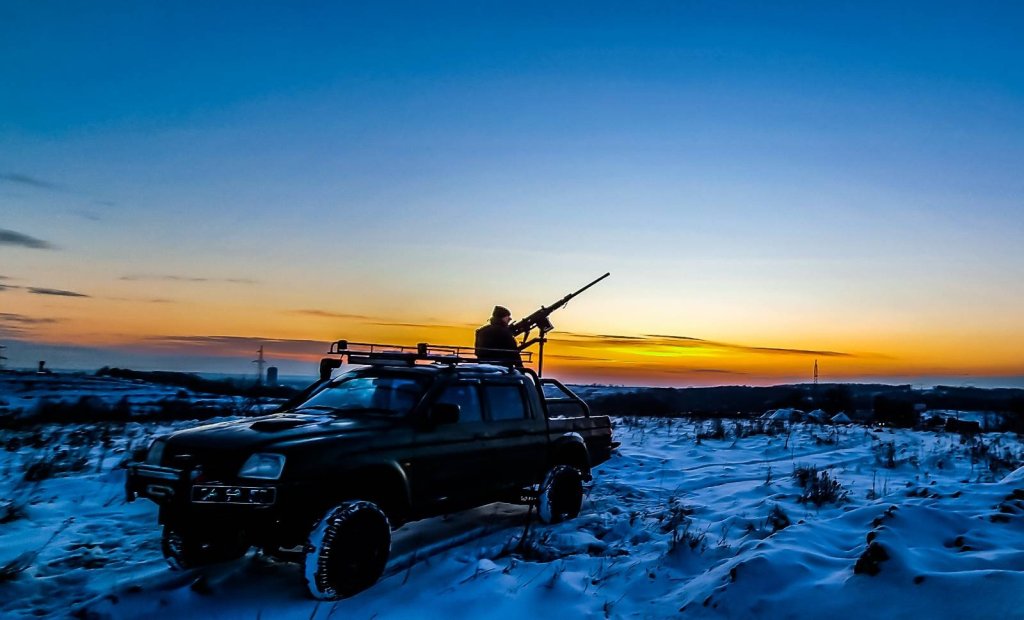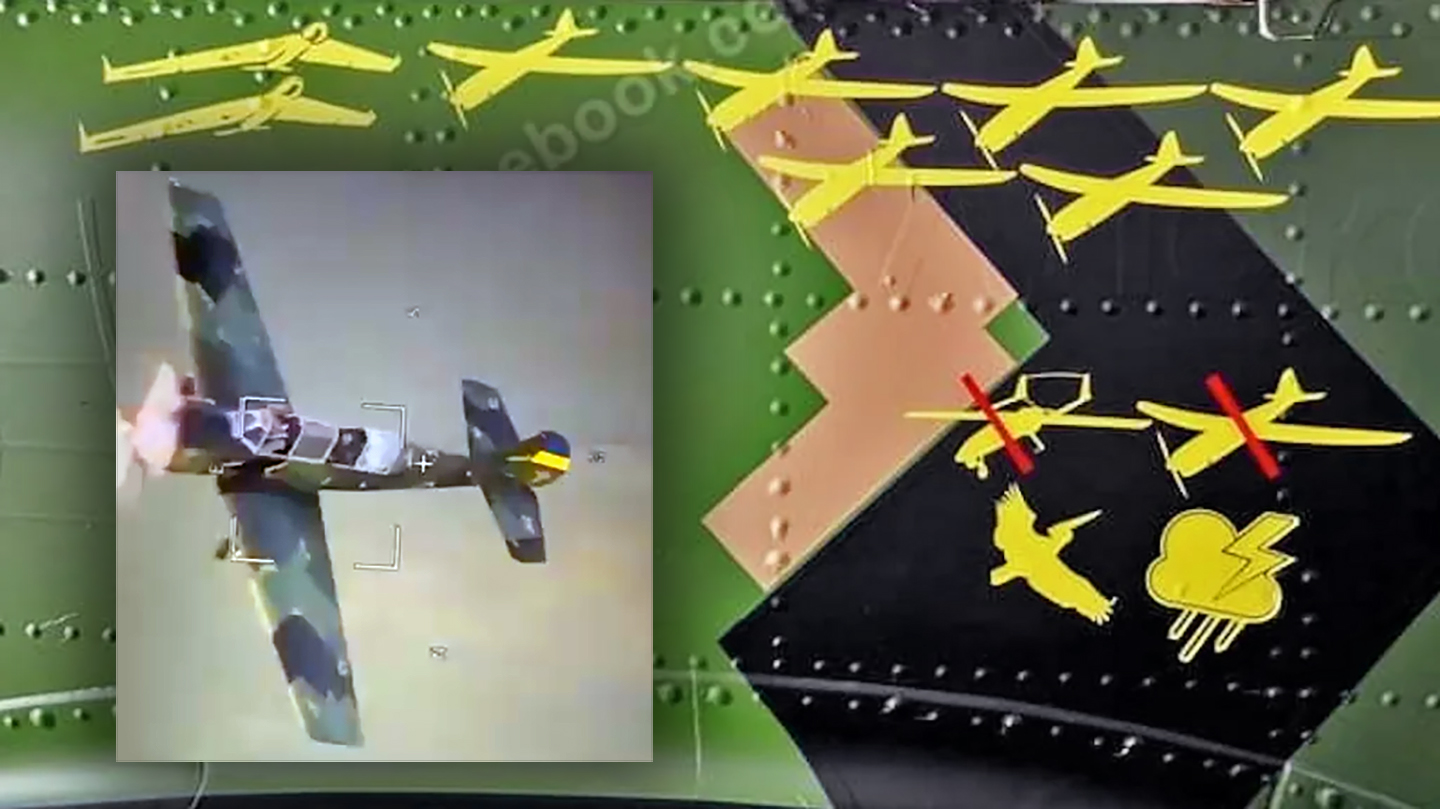A propeller-driven Yak-52 primary training aircraft has appeared with an impressive collection of kill marks displayed on its fuselage; seemingly confirmation of its success in having been pressed into service as a drone-killer. While we reported on a series of previous videos showing the use of Soviet-era Yak-52s to shoot down Russian drones, the latest evidence suggests that the unorthodox solution could be becoming a more important part of Ukraine’s multilayered air defenses.


Two new photos that first appeared today on Facebook, before being deleted, show a Yak-52 in a hangar, with a geometric or ‘digital’ camouflage scheme, apparently tailored for low-level operations over the ground. An aircraft in this same scheme was previously seen in a video captured from the perspective of a Russian drone, as you can see here. In one of the new photos, the tally of kills is displayed below the cockpit and shows, in yellow, two ZALA 421-16E and six Orlan-10/30 series drones.
The ZALA 421-16E is a flying-wing type, weighing around 20 pounds and used primarily for surveillance over the front line of the battlefield. The Orlan-10/30 series is among the most widely used Russian drones in Ukraine, the smaller Orlan-10 weighing around 35 pounds, while the larger Orlan-30 tips the scales at around 90 pounds. It’s also primarily used for surveillance and targeting, being fitted with an electro-optical sensor package and laser designator.


More intriguingly, there are additional marks showing single examples of the Iranian-designed Mohajer-6, with its characteristic twin-boom configuration, and another Orlan-10/30 series drone. Both are crossed through with a single red line and, below them, there are depictions of a pelican and a stylized thundercloud, respectively. There have been suggestions that the crew of the Yak-52 witnessed the destruction of these last two drones when they fell victim to the bird and a lightning strike. It’s also possible that the Yak-52 survived both a bird strike and a thunderstorm, although we simply don’t know for sure.
What appears to be clear is the increasing adoption of Yak-52s for drone-hunting duties, especially in the south of Ukraine, far behind the front lines. So far, at least two and possibly three of the aircraft have been noted in a counter-drone role, although there remain a number of uncertainties around the details of how they actually go about their missions. It should also be noted that the Yak-52 seen in the photos today may reflect that one of the earlier examples was repainted.
The scale of Russian drone activity over their country means that the Ukrainians are employing a wide range of air defense systems to counter them. Putting aside non-kinetic options such as electronic warfare, these extend all the way from mobile fire teams equipped with machine guns and searchlights to Patriot air defense systems with their long-range surface-to-air missiles.

The first time we observed a Yak-52 intercepting a drone was in April of this year. The target in that footage was another Orlan, which had deployed its orange-colored landing parachute, although it was unclear if this was activated before or after the Yak-52 — wearing distinctive blue and yellow wing stripes — began its attack, which was seen maneuvering around the drone in tight circles.

Reports so far indicate that the Yak-52 carries a gunner in the rear cockpit, who takes aim on drones using some kind of infantry weapon, likely a light machine gun.
Another video, showing the Yak-52 with a ‘digital’ camouflage scheme, or one painted in the same way, emerged earlier this month, the engagement being recorded by the drone that was apparently under attack. An individual could be seen in the open rear cockpit of the Yak-52, but it’s not possible to make out what weapon they were carrying.
The Yak-52 drone-killer aircraft is said to be operated by crew from Ukraine’s Civil Air Patrol, a civilian organization that consists mainly of amateur aviators and private aircraft owners. The needs of the conflict, and specifically the drone threat, have seen the organization field a so-called Tactical Aviation Group to “destroy enemy UAVs.”
An earlier video of a Yak-52 apparently operated by the Tactical Aviation Group of Ukraine’s Civil Air Patrol:

Previous videos emphasized the World War I-style nature of this kind of air combat, fought purely within visual range, likely with hand-operated rifle-caliber armament, and at very low level. What was less clear was how successful the Yak-52 has been in actually shooting down drones. In their favor, a lot of the drones of the types being intercepted operate on autopilot, with no ‘pilot in the loop,’ so they are unable to maneuver away or take evasive action.
As we have pointed out before, aiming a weapon by hand, using iron sights, with the slipstream of the aircraft to contend with, and two separate bodies moving three-dimensionally through the air, is hardly easy. While slow flying, the kinds of drones being intercepted are, for the most, also very small targets. As well as the challenges in actually getting into a suitable firing position, there is the wider problem of detecting the drone in the first place and vectoring the Yak-52 pilot onto it. This part of the engagement process may rely on the system of ground observers that Ukraine has implemented, driven by the drone threat, which also includes microphone and cellphone-based alert systems.

As for the Yak-52, it is an aerobatic platform, a feature which would be useful in certain engagements with drones, and the fact that it’s a popular mount for flying clubs and civilian organizations around the country should mean that these aircraft and people to fly them are available in useful numbers. Spare parts and maintenance shouldn’t be a major problem, either.
On the other hand, while a dedicated armed version of the Yak-52 was developed in Soviet times, the aircraft now available to Ukraine are strictly civilian in terms of their equipment. Their armament fit, at best, will be highly extemporized if not outright crude, although it’s possible that some kind of gun mounting and sighting system has been developed.
If the kill marks seen on the Yak-52 in the recent photo all represent genuine shoot downs, this would certainly speak to the utility of the platform, at least on some level, as well as to the training that its operators have received. This is the other major burden to consider, although it’s reasonable to assume that there is a cadre of experienced former military aviators who are too old for Ukrainian Air Force service but can nonetheless take part in these anti-drome efforts.

Overall, operating a light, slow-flying, agile platform like the Yak-52 could make some sense, especially in areas where Russian drones proliferate most deep behind the front lines.
On the other hand, operating an aircraft like this anywhere near Russian air defense systems would be extremely unwise bearing in mind their inherent vulnerability. This kind of exigency also points to the continued need for additional and more modern ground-based air defense systems for Ukraine, to ensure more effective coverage against drones — as well as missiles and aircraft — can be extended over the areas it’s needed.
Hopefully, now that the kill tally has come to light, it might be followed by more details about how these diminutive propeller aircraft are being used to tackle day-flying drones, and what their overall success rate looks like.
At the very least, we now have further evidence of Ukraine’s willingness to successfully adapt to the demands of the drone war in particular, putting to use the equipment they have to hand as this threat continues to intensify.
Contact the author: thomas@thewarzone.com
